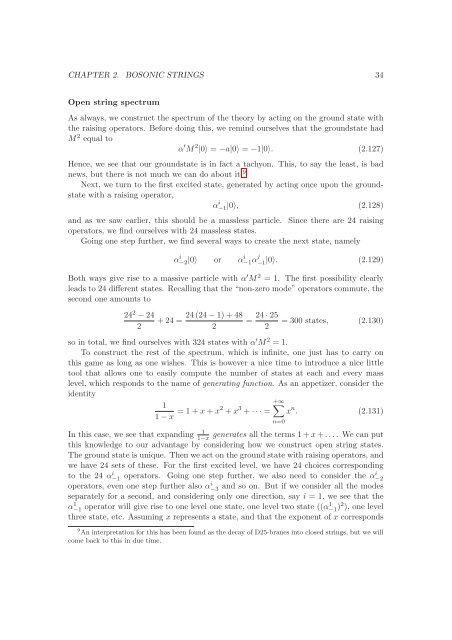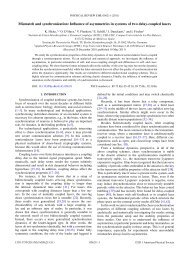DBI Analysis of Open String Bound States on Non-compact D-branes
DBI Analysis of Open String Bound States on Non-compact D-branes
DBI Analysis of Open String Bound States on Non-compact D-branes
Create successful ePaper yourself
Turn your PDF publications into a flip-book with our unique Google optimized e-Paper software.
CHAPTER 2. BOSONIC STRINGS 34<str<strong>on</strong>g>Open</str<strong>on</strong>g> string spectrumAs always, we c<strong>on</strong>struct the spectrum <str<strong>on</strong>g>of</str<strong>on</strong>g> the theory by acting <strong>on</strong> the ground state withthe raising operators. Before doing this, we remind ourselves that the groundstate hadM 2 equal toα ′ M 2 |0〉 = −a|0〉 = −1|0〉. (2.127)Hence, we see that our groundstate is in fact a tachy<strong>on</strong>. This, to say the least, is badnews, but there is not much we can do about it. 9Next, we turn to the first excited state, generated by acting <strong>on</strong>ce up<strong>on</strong> the groundstatewith a raising operator,α i −1|0〉, (2.128)and as we saw earlier, this should be a massless particle. Since there are 24 raisingoperators, we find ourselves with 24 massless states.Going <strong>on</strong>e step further, we find several ways to create the next state, namelyα−2|0〉 i or α−1α i j −1 |0〉. (2.129)Both ways give rise to a massive particle with α ′ M 2 = 1. The first possibility clearlyleads to 24 different states. Recalling that the “n<strong>on</strong>-zero mode” operators commute, thesec<strong>on</strong>d <strong>on</strong>e amounts to24 2 − 242+ 24 =24 (24 − 1) + 482=24 · 252= 300 states, (2.130)so in total, we find ourselves with 324 states with α ′ M 2 = 1.To c<strong>on</strong>struct the rest <str<strong>on</strong>g>of</str<strong>on</strong>g> the spectrum, which is infinite, <strong>on</strong>e just has to carry <strong>on</strong>this game as l<strong>on</strong>g as <strong>on</strong>e wishes. This is however a nice time to introduce a nice littletool that allows <strong>on</strong>e to easily compute the number <str<strong>on</strong>g>of</str<strong>on</strong>g> states at each and every masslevel, which resp<strong>on</strong>ds to the name <str<strong>on</strong>g>of</str<strong>on</strong>g> generating functi<strong>on</strong>. As an appetizer, c<strong>on</strong>sider theidentity1+∞∑1 − x = 1 + x + x2 + x 3 + · · · = x n . (2.131)n=0In this case, we see that expanding 11−xgenerates all the terms 1 + x + . . .. We can putthis knowledge to our advantage by c<strong>on</strong>sidering how we c<strong>on</strong>struct open string states.The ground state is unique. Then we act <strong>on</strong> the ground state with raising operators, andwe have 24 sets <str<strong>on</strong>g>of</str<strong>on</strong>g> these. For the first excited level, we have 24 choices corresp<strong>on</strong>dingto the 24 α−1 i operators. Going <strong>on</strong>e step further, we also need to c<strong>on</strong>sider the αi −2operators, even <strong>on</strong>e step further also α−3 i and so <strong>on</strong>. But if we c<strong>on</strong>sider all the modesseparately for a sec<strong>on</strong>d, and c<strong>on</strong>sidering <strong>on</strong>ly <strong>on</strong>e directi<strong>on</strong>, say i = 1, we see that theα−1 1 operator will give rise to <strong>on</strong>e level <strong>on</strong>e state, <strong>on</strong>e level two state ((α1 −1 )2 ), <strong>on</strong>e levelthree state, etc. Assuming x represents a state, and that the exp<strong>on</strong>ent <str<strong>on</strong>g>of</str<strong>on</strong>g> x corresp<strong>on</strong>ds9 An interpretati<strong>on</strong> for this has been found as the decay <str<strong>on</strong>g>of</str<strong>on</strong>g> D25-<strong>branes</strong> into closed strings, but we willcome back to this in due time.
















